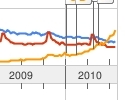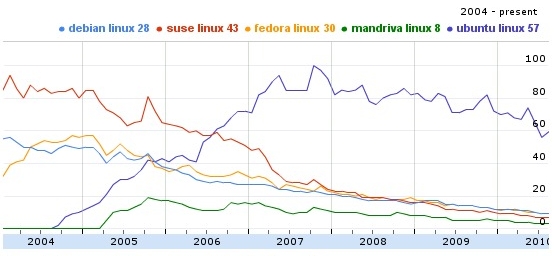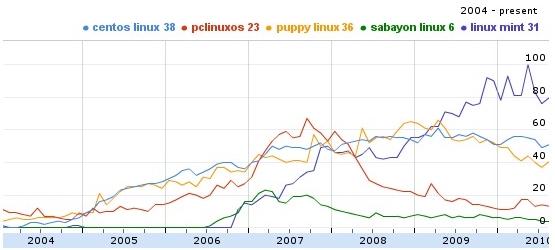Linux distribution popularity trends plotted
Last updated Aug 20, 2010 — 14114 views
In order to get a sense of the popularity of various Linux distributions over the past several years, we entered their names into Google’s search insights tool and grabbed images of the resulting graphs. The graphs display some fascinating trends and bode well for the future of Linux.
Graphs tracing the popularity of 14 of the most prominent Linux distributions appear below, along with our observations and comments. Bear in mind that the graphs do not represent distribution sales, downloads, or installed base; rather, the data is based entirely on the number of Google searches containing each distribution’s name per unit time as reported by Google’s search insights tool.
Top-tier distros: Debian, SUSE, Fedora, Mandriva, Ubuntu
The first graph shows the long-term trends of five mature, top-tier distributions: Debian, SUSE, Fedora, Mandriva, and Ubuntu. The meteoric rise of Ubuntu, which parallels the gradual decline of the more mature major Linux distributions, dominates the picture. Additional comments follow the graph.

(source data)
Some further observations:
- SUSE’s high popular at the start of the period is largely due to the acquisition of SUSE by Novell in November of 2003.
- What appears to be a rapid rise in Mandriva’s fortunes in 2005 actually is due to it having been a renamed version of Mandrake.
- Fedora’s initially high rate of growth is due to it having been spawned in late 2003 as the community-supported basis of Red Hat’s Linux distribution.
It’s fascinating to observe how rapidly Ubuntu — essentially a spiffed-up, user-friendly version of Debian — could break away from the pack to rapidly attain worldwide prominence. In parallel with that phenomenon, the four most popular Linux distributions at the start of the graph’s time period — Debian, Fedora, SUSE, and Mandriva — have exhibited a gradual, steady decline along a common trajectory. Ubuntu’s own peak may have occurred in mid-2008, roughly four years after its launch. Remember: the graph does not reflect installed base, or even new installs — it’s simply a reflection of keyword googling levels.
Shortly, we’ll get a glimpse of what seems likely to be the next major Linux phenomenon.
Mature 2nd-tier distros
Here we plot the popularity trends for searches relating to Slackware, Gentoo, Arch, and CentOS, with Mandriva as a reference. CentOS, a free clone of Red Hat Linux launched in 2004, benefited immediately from the existing popularity of Red Hat’s commercial Linux distribution along with that of the free Fedora project and, as seen, ends up at the head of this pack.

(source data)
Newer 2nd-tier distros
Next, we take a look at the popularity trends of PCLinuxOS, Puppy, Sabayon, and Linux Mint, with CentOS as a reference. Note how Linux Mint rises up above this group — apparently following in the footsteps of Ubuntu, on which it is based.

(source data)
Invasion of the androids
Last — but far from least — we plot the relative search popularities of Linux, Ubuntu, and Android. What’s noteworthy here, is that Android is the first Linux spin to take on a life of its own within consumer devices. It’s certainly not the first use of Linux as an OS for devices; what’s unique, is that it’s the first branded Linux-based OS to be widely marketed to consumers.

(source data)
Many of the Linux distributions listed in this post are briefly described in this recent DeviceGuru article. For continually-updated distribution descriptions, ranking, and news, visit DistroWatch.
I can tell you that this data is flawed, simply because up until 2004, Mandriva was the most widely used desktop distro. It was also #1 for a long time on Distrowatch. The only thing I can think of is that you used the name Mandriva without considering it was called Mandrake before 2004.
@LinuxLover: I realize there is that discontinuity. You can see the search expressions in the graphs, since they’re actually real-time reports. To see how Mandriva (Mandrake) was doing before the name change, have a look at this comparison, which includes Debian and SUSE for comparison:
(source data)
I once compared Ubuntu to pussy and Ubuntu was more popular. There is no way! Google trend data is flawed.
If this is based purely on search queries then wouldn’t it make sense that a larger distribution with a larger community would be specified in queries for bug documentation and troubleshooting. Also as distributions reach maturity and ship with more features and less critical flaws, the number of queries would also drop?
I’m with Skeptical on this one. Although Google search queries are an interesting metric, they’re probably not as reliable an indicator of popularity for distributions with a fairly complete documentation set, well know community resources and the kind of stability that comes through maturity.Ubuntu makes a terrific desktop system, and it surely has earned a top spot in the rankings for that. But Red Hat Enterprise Linux and its not-at-all-evil twin, CentOS, own the data center. While I’d love to run Ubuntu, or even Fedora, on my desktops for the convenience that being cutting edge provides, because my day job involves managing several hundred RHEL systems, I run CentOS to maintain my edge.
Hm, the overall trend seems to be that the use of Linux as an user sysem is decreasing… Not good.
Paai
I’d like to see a comparison with Mac OS X. I am guessing the rise in popularity of Mac OS X at least coincides with the decrease in (some) of the distributions mentioned. Of course, this doesn’t definitively tell us if Mac OS X is causing this decrease or simply correlated with it, but I don’t think anyone is claiming this to be a statistically-sound analysis anyway.
You can get some slightly more useful data by listing the alternative names for each grouping with pipes and parenthesis:
(mandrake|mandriva),(fedora|"red hat"|redhat|centos),(ubuntu),(suse|opensuse|novell),android. See the resulting graph.[quote] Hm, the overall trend seems to be that the use of Linux as an user sysem is decreasing… Not good. [/quote]
Just the opposite. Very good, because once you’ve found Linux and installed you will not be looking for it anymore.
As more and more people use Linux, less and less people rely on Google to find out something about that Linux, because the linux users themselves provide the info to neighbours, friends, collegues, …
Who looks for Windows on the Internet, nobody, simply because everybody knows it and almost everybody uses it.
You know, at least in the case of ubuntu it doesnt represent te overall searches for the distribution. Most searches are done using the name of a specific version, and perhaps then something more specific, ie “lucid reinstall grub” or “karmic repos” etcetc.
The same applies to the other distros with named versions. So i don’t think the graph represents the truth about linux distros popularity with accuracy.
comparing “Ubuntu” to “Ubuntu Linux” gives COMPLETELY different results:
* view graph *
I think people don’t call Ubuntu “Ubuntu Linux”, but just Ubuntu.
This happens with every other distro, which don’t have linux in their names
ENOUNITS
Years across, what down?
@Paul: Thanks for the tip regarding combining multiple search terms using a pipe symbol.
@alm: You are right about the ubuntu distributions being searched by just the distribution names as well.
Here goes yet another attempt. I entered the following:
ubuntu|lucid|karmic|dapper|breezy|gutsy|intrepid|hardy,windows+7|windows+xp|windows+vista|xp|vista(resulting graph)
All I can say is, google search terms dont seem to be a very reliable metric to gauge popularity. Also, I do get a feeling that many people have stopped googling distribution names 😉
There is an explanation if you do enough poking around on search insights (had to log in for this link to show up), takes a few minutes to wrap one’s head around:
http://www.google.com/support/insights//bin/answer.py?hl=en-US&answer=87285
Would be nice to see LinuxTrends talk a bit about what this means for their findings.
errno = 0; /* 🙂 */
* view graph *
Interestingly, “Microsoft Windows” and “Mac osx” exhibit the same decrease. I don’t know how exactly Google Trends works, but I attribute the decrease to the fact that more and more mainstream (i.e. less technical) people start using computers.
The major flaw here – as relates particularly to Linux Mint and Ubuntu – is pretty simple: very few people who use Mint will Google issues pertaining to their distro by using ‘Mint’ in their search terms.
That is to say, if you have an issue with Mint, you Google Ubuntu – because that’s where the answers lie. I’m sure there are a few users who don’t know to do this, but not many.
So actually, the rise of Linux Mint is considerably more meteoric than the third graph would indicate. It’s a killer distro. I’ve been using it for a couple of years and have wooed several people off Windows already.
Windows and Linux distros appear to be close in search results:
(mandrake|mandriva|fedora|”red hat”|redhat|centos|ubuntu|xbuntu|kbuntu|suse|opensuse|novell|linux|android),(“windows 95″|”windows 98″|”windows 2000″|”windows me”|”windows xp”|”windows vista”|”windows 7”),(freebsd|openbsd|netbsd),(“os x”)
(resulting graph)
And if you add Ubuntu to the mix an entire different picture arises: Ubuntu outshines the others by a large margin!
* view graph *
The real lesson is that Google Trends, or Insights, graphs only the frequency of search terms that have been used in Googling for information. Such graphs have no other significance and certainly aren’t related to any metrics that have meaning.
It isn’t that the trend data is flawed, it’s that it just isn’t showing you what you first assume it’s showing you. What do those numbers on the right represent? Hint: it ain’t thousands. This is TREND data.
Besides, do you really care how people who search for pussy on Google compare to just about anything else?
The discrepancy is easily explained; even gay people like Ubuntu whereas gay people tend not to like pussy.
This is also an interesting way to look at linux market share data.
Nice to see and interesting.
I have been using Ubuntu for almost 4 years and the first couple of years I used to Google Ubuntu, but now that Ubuntu and other distros have improved I am not Googling Ubuntu as much. This may account for the gradual decline recently for all of them.
Too bad. Eternal hype (and consequent disappointment that was promptly forgotten to start a new cycle) is the only thing going for Linux.
You assume that all gay people are men with this statement. I would venture that the amount of women that like pussy rivals the amount of men that don’t.
yes, counting queries is not a valid indicator of what is installed.
Example: I run a lab, and I might do an install a distro on 10 machines… but if I have a question, I might do one query and do some change on all 10 machines.
Example: usually only people who have questions do queries, so the results really should be about “most Linux distros with people who need help with Linux”, not about how many are installed.
Example: queries are about searches for information. I could easily posit that some other distros are more popular, their users just look up info about Ubuntu more often.
Example: some evil users out there have automated queries running 24×7 just to skew search results.
Example: TMN (track me not) users run unattended automated queries based on popular items in the on-line press. So, just mention Ubuntu alot and things like TMN reflect what is on web pages, not what people are really doing.
and on and on.
Hello.. Slackware user here (yes, we do exist, and yes, sometimes you are luckey enough to hear one of us bother to speak up)
It just dawned on me that no slackware user i know of type “slackware” in the search term on google.
Reason you ask? Simply because Slackware is a very very vanilla distro, so your best bet is to go directly to upstream of the the given piece of software you are experiencing a problem with.
Now this may sound a little condesending (and ok, it is), but dont you think it a little more likely that an Ubuntu user will type “ubuntu sound problem” in google, rather than “alsa.conf tutorial”?
Well.. there you have my two cent 😉
I’m curious what you define a “top tier” or “2nd tier” distribution. I’ve never heard that term before nor has my Google-Fu turned up anything that seems to group distributions the way ya’ll have. Usually I’d guess that “2nd tier” meant “based on another”, e.g. linux mint from ubuntu, sabayon from gentoo, or CentOS from Red Hat.
quote, “Android is the first Linux spin to take on a life of its own within consumer devices. It’s certainly not the first use of Linux as an OS for devices; what’s unique, is that it’s the first branded Linux-based OS to be widely marketed to consumers.” Actually, I believe Linspire (later taken over by Xandros) and Red Hat Desktop were first marketed to consumers.
lies, damnable lies and google trends
any kind of fine grained conclusions will be foolish.
gross observation is possible.
ubuntu is big player now.
i can combine that with what i know about server and embedded installations, and my guess, and it’s only a guess, is that ubuntu is a big player, bigger then everyone else, in the desktop arena.
but we already knew that, didn’t we.
this just “sorta” in not a precise way, confirms it.
FWIW, the following list shows how many times readers have clicked on the links in this article for each Linux distribution (as of Aug. 23, 2010):
linuxmint.com — 1,329
sabayon.org — 140
puppylinux.org — 118
pclinuxos.com — 106
centos.org — 97
ubuntu.com — 82
archlinux.org — 73
slackware.com — 72
debian.org — 59
gentoo.org — 55
mandriva.com — 28
opensuse.org — 27
fedoraproject.org — 25
The “2nd tier” distro groups contain distributions that would be so close to the bottom of the first graph that their trends would be hard to follow. By grouping them together on their own graph(s), with one distro from the “top tier” graph included as a reference, it’s easier to discern their trends.
Installing and selling 200+ Linux HP mini-towers each year, since 2006, Friends of the Library, Seminole County, Florida, has converted at least 700 folks to GNU/Linux Mint 6.0, 7.0, 8.0, and now, Linux Mint 9.0 “Isadora”!
HP Model d530, 2.66GHz systems are $50, and the 2.8GHz systems are $75.
All come with 48X CDrom, 512 MB DDR, 40GB Hard drive, keyboard, mouse, AC cord,
and 30 day warranty!
it cant really be considered accurate ubuntu get’s a lot of new users just learning the system and breaking this as they go which causes them to search for stuff concerning ubuntu a lot.
now compare that to someone like me who has been using unix systems for ever and a day and has been on suse for years and years. I almost never have a issue i cant figure out on my own and when i cant i use the suse community (IRC) not google to help me get the info i need.